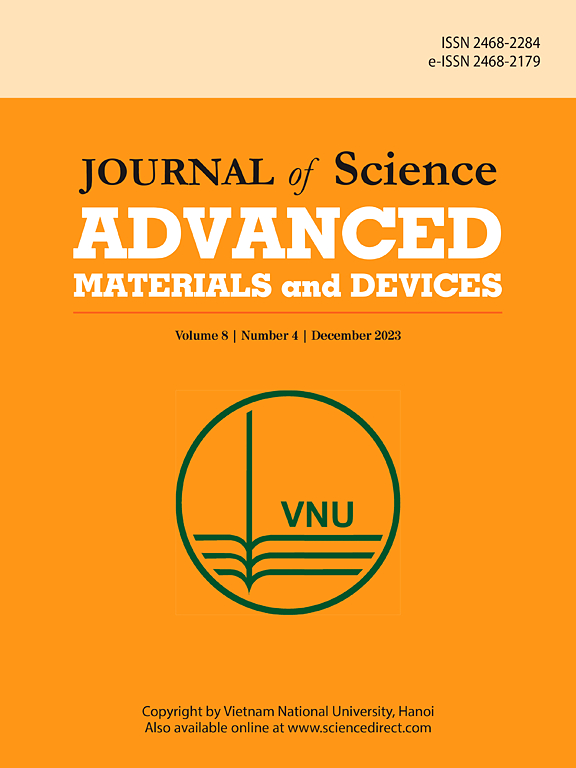The preparation of phosphor-in-glass from borosilicate waste glasses by microwave-heating method
IF 6.8
3区 材料科学
Q1 MATERIALS SCIENCE, MULTIDISCIPLINARY
Journal of Science: Advanced Materials and Devices
Pub Date : 2025-04-15
DOI:10.1016/j.jsamd.2025.100888
引用次数: 0
Abstract
This research investigated the production of a phosphorescent material using borosilicate glass wastes derived from damaged or broken laboratory glassware. The borosilicate glass powder was first mixed with SrAl2O4: Eu2+, Dy3+ phosphor at a weight ratio of 10 %. The samples were subsequently sintered in a domestic microwave oven at 800 W for varying durations (6, 8, 10, 12, and 14 min) and in an electric furnace at different temperatures (700, 800, 900, and 1000 °C) for one h. Only samples produced through sintering in an electric furnace revealed the development of cristobalite crystals. This might be attributed to the rapid heating of microwaves, which hindered the crystallization process. Nevertheless, phosphorescent samples subjected to temperatures between 700 and 900 °C or for durations of 8–12 min exhibited green light emission at 524 nm due to the electronic transition from 4f65d1 to 4f7 of Eu2+. At elevated sintering temperatures or longer sintering durations, the emission peak, however, underwent a blue shift toward shorter wavelengths, resulting in a change in the color of emitted light to a blue color. The current findings indicate that a microwave oven is an efficient alternative to an electric furnace for sintering, as it reduces both energy consumption and processing time. Crystallization inhibition is also achieved via microwave heating.

以硼硅酸盐废玻璃为原料,微波加热法制备玻璃内磷
本研究探讨了利用实验室玻璃器皿损坏或破碎后产生的硼硅酸盐玻璃废料生产磷光材料。首先将硼硅酸盐玻璃粉与SrAl2O4: Eu2+, Dy3+荧光粉以10%的质量比混合。样品随后在800 W的家用微波炉中进行不同时间(6、8、10、12和14分钟)的烧结,并在不同温度(700、800、900和1000℃)的电炉中进行1小时的烧结。只有通过电炉烧结产生的样品才显示出方石英晶体的发育。这可能是由于微波的快速加热阻碍了结晶过程。然而,由于Eu2+从4f65d1到4f7的电子跃迁,在700 - 900°C或8-12分钟的温度下,磷光样品在524 nm处显示出绿光发射。然而,在较高的烧结温度或较长的烧结持续时间下,发射峰经历了向短波长的蓝移,导致发射光的颜色变化为蓝色。目前的研究结果表明,微波炉是一种有效的替代电炉烧结,因为它减少了能耗和处理时间。通过微波加热也可以实现结晶抑制。
本文章由计算机程序翻译,如有差异,请以英文原文为准。
求助全文
约1分钟内获得全文
求助全文
来源期刊

Journal of Science: Advanced Materials and Devices
Materials Science-Electronic, Optical and Magnetic Materials
CiteScore
11.90
自引率
2.50%
发文量
88
审稿时长
47 days
期刊介绍:
In 1985, the Journal of Science was founded as a platform for publishing national and international research papers across various disciplines, including natural sciences, technology, social sciences, and humanities. Over the years, the journal has experienced remarkable growth in terms of quality, size, and scope. Today, it encompasses a diverse range of publications dedicated to academic research.
Considering the rapid expansion of materials science, we are pleased to introduce the Journal of Science: Advanced Materials and Devices. This new addition to our journal series offers researchers an exciting opportunity to publish their work on all aspects of materials science and technology within the esteemed Journal of Science.
With this development, we aim to revolutionize the way research in materials science is expressed and organized, further strengthening our commitment to promoting outstanding research across various scientific and technological fields.
 求助内容:
求助内容: 应助结果提醒方式:
应助结果提醒方式:


